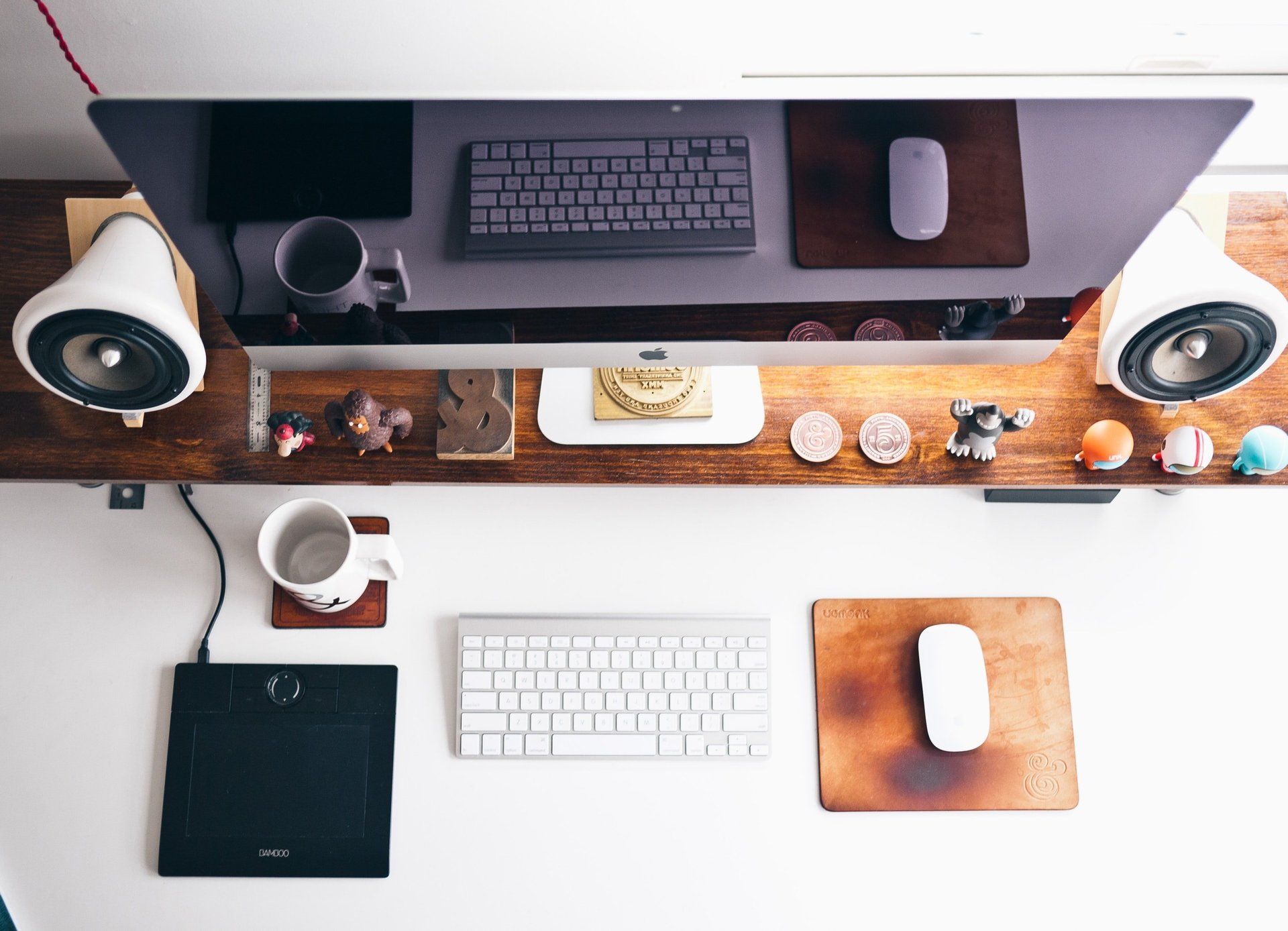Web design, UI, UX and web development: What are the differences?
Whether you are looking for a brand new website for your business or an update to your existing website, it can be hard to decide who should do the job.
Is there a difference between web design and web development? Or are they just different words for the same thing? And what about the difference between UI and UX?

The basics
Before we look at them more closely, these are the basic definitions of the four areas:
- Web design is an umbrella category for everything to do with designing both the look and useability of a website. Both UI and UX are a part of web design.
- Web development is the technical part of creating a website, focusing on code. It can be divided into ‘front-end’ and ‘back-end’ development.
- User experience (UX) is a specialist area of design dealing with user behaviour when using a website or app.
- User interface (UI) is a part of web design which deals specifically with the controls people use to interact with a website or app.
Separating the four individual areas isn’t always easy, as there is a lot of crossover between them. The internet is constantly evolving, and so are the jobs which support it. The key isn’t so much about which area handles a particular task, but more about the way in which the four areas consider the task from a different point-of-view.
An example of this is the common problem of website loading time. Each area will consider it in a different way to come up with a solution.
If a page takes a long time to load, there’s either too much content or the content is too complex. A web designer will spend time adjusting and re-exporting assets, compressing image files and trimming pages of excess content to speed up the site.
A web developer would come at things from a different angle and try better file compression to reduce the file sizes of the content, CSS sprites to save bandwidth or a content delivery network to speed up loading times.
The focus for a UI designer would be on making sure the controls are as responsive as possible. They would want to ensure the interface is simple enough for interactivity to be instantaneous.
The likelihood of a user leaving your site after a few seconds (bounce) increases for every additional second a site takes to load. So a UX expert would prioritise reducing the load time on the home and landing pages first, before dealing with the issue across the whole site.
In an ideal world, you would hire all four of these roles to work on your site. But the reality is that would be too expensive for many businesses, especially start-up companies. So the likelihood is that you will choose one or two areas to focus on more than the others, or hire someone who has skills in all of the areas.
If your site is a fairly simple one, hiring a designer who can code would be a good place to start. Some UI designers have overlapping skills with web designers, while others have skills in both UI and UX.
You should also consider whether your main focus is a website or an app, and the distinction between your desktop site and mobile site. Every designer and developer will have their own speciality, so make sure you hire someone who can meet your requirements.
Most web designers work mainly on websites rather than apps. So, if you are looking for a designer for iOS or Android apps, you will most likely need to find a UX or UI designer.
Which specialist can help with your particular business goals? And what should you consider when hiring them? Here we take a closer look at each of the specialities…
Web design
Fundamentally, web design is all about the visual appearance and functionality of a website. It’s a field which has its roots in graphic design. If a web designer has been in the job for a long time, it is likely that they initially got into web design through graphic design.
There are a number of subcategories of web design, including both UX and UI, but also CRO (conversion rate optimisation) and IA (information architecture, which deals with site mapping and navigation).
But web design is so much more than graphic design. Whether working with websites or apps, designers need to understand and keep up to date with technical constraints, functionality, user expectations and digital trends.
Web designers also need to understand business, so that their designs can encourage visitors to take the right actions. They need to know about digital sales tactics and how site layout influences user behaviour.
The web designer handles the traditional graphic design side of things, like colour and font. He or she may also create icons and graphics from scratch to help create your online brand identity.
The design process usually involves a web designer coming up with a number of ideas and prototypes for a client to test and approve. Once they have come up with a design you are happy with, it is passed to the developer for coding.
Checklist for hiring a web designer:
- They don’t need to be the ‘best’ designer, but they do need to be the best fit for your business
- Every designer has their own style, so look at their portfolio. Does it meet with your expectations for your brand?
- Is their preferred software compatible with the software used by the rest of the team?
- Can they meet your deadlines and fit in with your schedule?
Web development
The big difference between a web designer and a web developer is the use of code. Web developers use the most confusing language, but you don’t need to understand most of it. All that really matters is that they know what they are talking about!
Web development is divided into two main areas – front-end and back-end.
The front-end is the client side of a website. The code used for the front-end is what brings the appearance of the website to life. The front-end developer will work closely with the designer to make the design vision a reality. As we said earlier, there is a lot of crossover between all of the roles, so sometimes the web designer will also handle the development of the front-end.
The back-end is the server side of a website. The back-end developer works on the digital system of resources on a server, coding the data in the database and optimising how it is delivered. Without the back-end work, there would be no front-end.
There are also full-stack developers who can work on both front-end and back-end development. They are a good option for start-ups and smaller companies who can’t afford to pay too much for their web development.
Checklist for hiring a web developer:
- It doesn’t matter if you understand the language, but tell a developer what you would like and listen to their recommendations
- Check their portfolio – do their previous designs work in the way you would like your site to work?
- Can your developer work with your designer? If some design ideas aren’t possible, you can save time if the developer lets the designer know from the start
User experience (UX)
UX is web design with the focus on the user’s perspective. It is all about understanding the why. Why does a visitor click on the red button instead of the blue one? Why hasn’t the user filled out the form? Why don’t they scroll to the bottom of the page?
UX considers how the layout of a web page affects a visitor. UX designers can come up with page designs which are more likely to encourage users to make a purchase or sign up for something.
Although it may seem like you don’t need a UX designer when you already have a web designer, there is a direct correlation between good UX design and meeting your business goals. Optimising the design of a website can encourage people to take certain actions and create an atmosphere which is more conducive to that happening.
UX designers use a lot of graphic design skills – like using colour for emotion, attracting attention with the size and placement of images and creating a flow across a page and through your site which is easy to follow.
Checklist for hiring a UX designer:
- If you don’t have the budget for a separate UX designer, ask candidates in other fields if they can handle UX in addition to their main expertise.
- Test drive other sites and apps they have worked on. Are they easy and enjoyable to use?
User interface (UI)
User interface (UI) means creating something we can all use without thinking about it. Can you remember when you learned that the bin icon meant delete? Exactly!
If the UI designer does their job well and creates a really intuitive interface, users don’t even have to think about how to use it. Which is what all businesses really want from their own websites.
If a user has to search for a button or spend time thinking about how to use the controls, the UI design isn’t fit for purpose. The goal is to create self-explanatory controls that users can understand at a glance.
UX isn’t in competition with UI – the two need to work closely together to achieve the best outcomes for your business.
UI designers focus on:
- The layout of a screen - how should information be organised? How much space is needed between different elements?
- Responsive design – making sure the design works across all screen sizes.
- Designing the essential icons, buttons, sliders and scrollbars.
- Designing the interactions - how does a button react when a visitor clicks on it?
UI designers also need to find the right balance between providing a big range of options and not cluttering the screen. That’s where techniques like hover controls and pull-out menus come in. It is up to the UI designer to decide which controls should be there at all times and which can be hidden.
Checklist for hiring a UI designer:
- Test drive their previous sites - can you find everything you need? Was the site or app easy to use?
- Make sure the UI designer has worked in your industry or for your type of project. The ‘best’ UI designer might not be the best for you.
What does your business need?
In an ideal world, every business would have a brilliant website, designed by a developer, designer, UI and UX experts. But the reality is that is too expensive for many companies, especially start-ups. Perhaps you already have a website which is already functioning reasonably well, but you suspect it could do a bit better?
In either case, you may want to enlist the help of one or two experts to improve things. There is nothing to say that a web designer is ‘better’ or more important than a UI designer. While start-ups and tech companies in particular often prioritise UI and UX designers, the right person for the job is the right person for your business. And that won’t be the same person as it is for someone else’s business, even in the same sector.
To help you understand which one your business needs, here are some examples of issues which each area can help you to resolve. If you already have a website, carry out some user tests to find out where people have problems on your site.
Web design
- Website doesn’t look right on mobile devices
- Website design looks out-of-date
- Visitors aren’t going to the pages you want them to
- Images are poor quality
- Time spent on a page is too short
Web development
- Site functions aren’t working as they should
- Site goes offline too often
- Some content fails to load
- Too many 404 errors
- Assistance with web security and hack prevention
UX
- High bounce rate (visitors leave very quickly
- Poor conversion rates (high levels of traffic, but few conversions
- Users leave after one page, rather than staying and exploring
UI
- Complaints about being unable to do things or find things
- Poor navigation
- Lack of social sharing options
- Lack of customisation options
We hope this article makes the differences between web design, web development, UI and UX a bit clearer. We are sure that you will now realise that, while there are differences between the disciplines, there are also a lot of similarities and a lot of crossover.
Finding the right web professional to work on your site is really a matter of identifying what your key issues are, then checking the portfolios of a number of professionals to make sure you find one who understands your business and your needs.
More Posts.


Cotswold Web Services.









